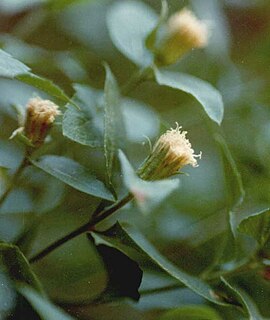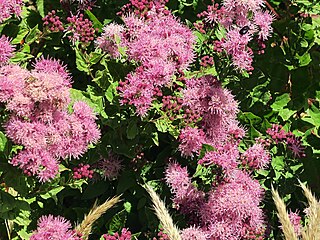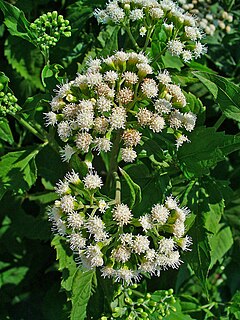
Ageratina altissima, also known as white snakeroot, richweed, or white sanicle, is a poisonous perennial herb in the family Asteraceae, native to eastern and central North America. An older binomial name for this species is Eupatorium rugosum, but the genus Eupatorium has undergone taxonomic revision by botanists, and a number of the species that were once included in it have been moved to other genera.

Eupatorium is a genus of flowering plants in the aster family, Asteraceae, containing from 36 to 60 species depending on the classification system. Most are herbaceous perennials growing to 0.5–3 m (1.6–9.8 ft) tall. A few are shrubs. The genus is native to temperate regions of the Northern Hemisphere. Most are commonly called bonesets, thoroughworts or snakeroots in North America. The genus is named for Mithridates Eupator, king of Pontus.

E. Lucy Braun was a prominent botanist, ecologist, and expert on the forests of the eastern United States who was a professor of the University of Cincinnati. She was the first woman to be elected President of the Ecological Society of America, in 1950. She was an environmentalist before the term was popularized, and a pioneering woman in her field, winning many awards for her work.

Ageratina shastensis is a species of snakeroot which is endemic to Shasta County, California. It is known by the common names Mt. Shasta snakeroot and Shasta eupatorium.

Ageratina herbacea is a North American species of flowering plants in the daisy family known by the common names fragrant snakeroot and Apache snakeroot. It is native to desert regions of the southwestern United States and northern Mexico. It grows in rocky slopes in conifer forests and woodlands.

Ageratina occidentalis is a species of flowering plant in the daisy family known by the common name western snakeroot or western eupatorium. It is native to the western United States where it grows in several types of habitat. It is found in California, Oregon, Washington, Idaho, Montana, Nevada, and Utah.

Erigeron pulchellus, the Robin's plantain, blue spring daisy or hairy fleabane, is a North American species of plants in the daisy family. It is widespread across much of the United States and Canada from Québec and Ontario south as far as eastern Texas and the Florida Panhandle.
Malaxis bayardii, or Bayard's adder's-mouth orchid, is a species of orchid native to northeastern North America. It is found from Massachusetts to North Carolina, with isolated populations in Ohio and Nova Scotia. There are historical reports of the plant formerly growing in Vermont and New Jersey, but it seems to have been extirpated in those two states It grows in dry, open woods and pine barrens at elevations of less than 600 m.

Ageratina aromatica, also known as lesser snakeroot and small-leaved white snakeroot, is a North American species of plants in the sunflower family. It is widespread and common across much of the eastern and southern United States from Louisiana to Massachusetts, as far inland as Kentucky and Ohio.
Ageratina lemmonii, called the Lemmon's snakeroot, is a North American species of plants in the sunflower family. It is found only in the southwestern United States in the states of Arizona and New Mexico, as well as the states of Sonora, Sinaloa, Chihuahua and Durango in Mexico.
Ageratina paupercula, called the Santa Rita snakeroot, is a North American species of shrubs or perennial herbs in the sunflower family. It is found only in the states of Arizona, Sonora, Chihuahua, Durango, Nayarit, and Jalisco.
Ageratina rothrockii is a North American species of plants in the sunflower family. It is found only in the southwestern United States in the states of Arizona, New Mexico, and Texas, as well as the states of Sonora, Coahuila, Chihuahua, and Durango in Mexico.
Ageratina wrightii is a North American species of plants in the sunflower family. It is native to the southwestern United States and northern Mexico.
Bidens eatonii is a North American species of flowering plant in the daisy family. It is native to eastern Canada and the northeastern United States.
Bidens heterodoxa, the Connecticut beggarticks, is a North American species of flowering plant in the daisy family. It is native to eastern Canada and the northeastern United States (Connecticut).
Bidens hyperborea is a coastal species of flowering plant in the daisy family. It grows along the coasts of Hudson Bay, the Arctic Ocean, and the North Atlantic Ocean in eastern Canada and the northeastern United States.
Boltonia caroliniana, common name Carolina doll's-daisy, is a North American species of plants in the sunflower family. It is found only in the southeastern United States, primarily in the states of North Carolina, South Carolina, and Virginia with a few isolated populations in western Georgia.
Rubus aculifer, the thorny dewberry, is a rare North American species of flowering plant in the rose family.
Rubus tholiformis is a rare North American species of flowering plant in the rose family. It has been found only in eastern Canada and the northeastern United States.
Rubus kennedyanus is a rare North American species of brambles in the rose family. It is found in eastern Canada and in the north-central United States.









